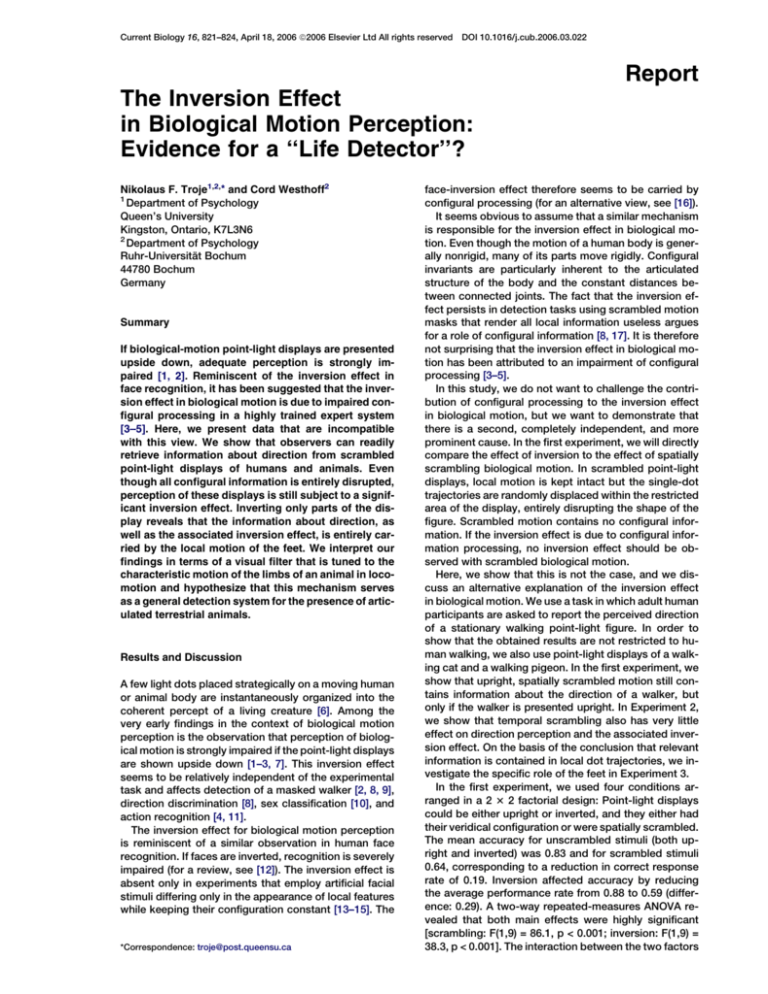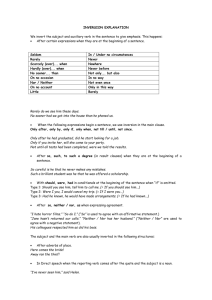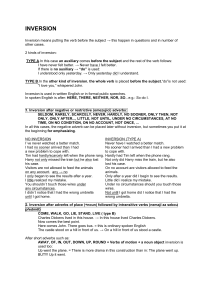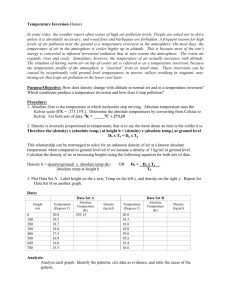
Current Biology 16, 821–824, April 18, 2006 ª2006 Elsevier Ltd All rights reserved
DOI 10.1016/j.cub.2006.03.022
Report
The Inversion Effect
in Biological Motion Perception:
Evidence for a ‘‘Life Detector’’?
Nikolaus F. Troje1,2,* and Cord Westhoff2
1
Department of Psychology
Queen’s University
Kingston, Ontario, K7L3N6
2
Department of Psychology
Ruhr-Universität Bochum
44780 Bochum
Germany
Summary
If biological-motion point-light displays are presented
upside down, adequate perception is strongly impaired [1, 2]. Reminiscent of the inversion effect in
face recognition, it has been suggested that the inversion effect in biological motion is due to impaired configural processing in a highly trained expert system
[3–5]. Here, we present data that are incompatible
with this view. We show that observers can readily
retrieve information about direction from scrambled
point-light displays of humans and animals. Even
though all configural information is entirely disrupted,
perception of these displays is still subject to a significant inversion effect. Inverting only parts of the display reveals that the information about direction, as
well as the associated inversion effect, is entirely carried by the local motion of the feet. We interpret our
findings in terms of a visual filter that is tuned to the
characteristic motion of the limbs of an animal in locomotion and hypothesize that this mechanism serves
as a general detection system for the presence of articulated terrestrial animals.
Results and Discussion
A few light dots placed strategically on a moving human
or animal body are instantaneously organized into the
coherent percept of a living creature [6]. Among the
very early findings in the context of biological motion
perception is the observation that perception of biological motion is strongly impaired if the point-light displays
are shown upside down [1–3, 7]. This inversion effect
seems to be relatively independent of the experimental
task and affects detection of a masked walker [2, 8, 9],
direction discrimination [8], sex classification [10], and
action recognition [4, 11].
The inversion effect for biological motion perception
is reminiscent of a similar observation in human face
recognition. If faces are inverted, recognition is severely
impaired (for a review, see [12]). The inversion effect is
absent only in experiments that employ artificial facial
stimuli differing only in the appearance of local features
while keeping their configuration constant [13–15]. The
*Correspondence: troje@post.queensu.ca
face-inversion effect therefore seems to be carried by
configural processing (for an alternative view, see [16]).
It seems obvious to assume that a similar mechanism
is responsible for the inversion effect in biological motion. Even though the motion of a human body is generally nonrigid, many of its parts move rigidly. Configural
invariants are particularly inherent to the articulated
structure of the body and the constant distances between connected joints. The fact that the inversion effect persists in detection tasks using scrambled motion
masks that render all local information useless argues
for a role of configural information [8, 17]. It is therefore
not surprising that the inversion effect in biological motion has been attributed to an impairment of configural
processing [3–5].
In this study, we do not want to challenge the contribution of configural processing to the inversion effect
in biological motion, but we want to demonstrate that
there is a second, completely independent, and more
prominent cause. In the first experiment, we will directly
compare the effect of inversion to the effect of spatially
scrambling biological motion. In scrambled point-light
displays, local motion is kept intact but the single-dot
trajectories are randomly displaced within the restricted
area of the display, entirely disrupting the shape of the
figure. Scrambled motion contains no configural information. If the inversion effect is due to configural information processing, no inversion effect should be observed with scrambled biological motion.
Here, we show that this is not the case, and we discuss an alternative explanation of the inversion effect
in biological motion. We use a task in which adult human
participants are asked to report the perceived direction
of a stationary walking point-light figure. In order to
show that the obtained results are not restricted to human walking, we also use point-light displays of a walking cat and a walking pigeon. In the first experiment, we
show that upright, spatially scrambled motion still contains information about the direction of a walker, but
only if the walker is presented upright. In Experiment 2,
we show that temporal scrambling also has very little
effect on direction perception and the associated inversion effect. On the basis of the conclusion that relevant
information is contained in local dot trajectories, we investigate the specific role of the feet in Experiment 3.
In the first experiment, we used four conditions arranged in a 2 3 2 factorial design: Point-light displays
could be either upright or inverted, and they either had
their veridical configuration or were spatially scrambled.
The mean accuracy for unscrambled stimuli (both upright and inverted) was 0.83 and for scrambled stimuli
0.64, corresponding to a reduction in correct response
rate of 0.19. Inversion affected accuracy by reducing
the average performance rate from 0.88 to 0.59 (difference: 0.29). A two-way repeated-measures ANOVA revealed that both main effects were highly significant
[scrambling: F(1,9) = 86.1, p < 0.001; inversion: F(1,9) =
38.3, p < 0.001]. The interaction between the two factors
Current Biology
822
was not significant [F(1,9) = 1.1], reflecting the fact that
the performance decrease caused by inversion is similar for unscrambled (0.33) and for scrambled (0.24)
motion (Tukey’s Honest Significant Difference is 0.188,
p < 0.01). The participant’s sex and type of creature
(human, pigeon, or cat) had no effect.
The results of this first experiment are not compatible
with the hypothesis that the inversion effect in biological
motion is due to impaired configural processing. However, even though the spatial configuration of the dots
is not essential, the temporal pattern among them might
be of importance. The second experiment was designed
to investigate whether this is the case. Here, we added
conditions in which, in addition to spatial scrambling,
the relative phase between the different dots was randomly offset (Figure 1A, conditions e and f). Note that
after this manipulation, all dots still move with the
same fundamental frequency. Even though the phases
between the dots are no longer veridical, the phase relations among them stay constant throughout a single trial,
and the pattern still resembles a rhythmic gait. Therefore, we also added conditions in which the speeds of
the individual dots were multiplied by constant factors
picked randomly within a range between 0.5 and 2 (conditions g and h).
The performance exhibited in the first four conditions
(conditions a–d) confirms the results of Experiment 1. A
separate analysis of the accuracy data of these first four
conditions shows that both scrambling and inversion affect performance [F(1.9) = 14.3, p < 0.005, and F(1,9) =
67.2, p < 0.001, respectively] and that inversion similarly
affects intact and scrambled displays (no interaction between the two factors). Recognition of upright, scrambled biological motion is better than recognition of inverted scrambled motion (Tukey’s HSD test, p < 0.01).
In a second analysis, we compared the different conditions that employ stimuli with scrambled motion (conditions c – h) by means of a two-way ANOVA with factors
Inversion and Scrambling. Here, the second factor has
the three levels spatially scrambled, phase scrambled,
and random frequency. Inversion has a highly significant
effect [F(1,9) = 122, p < 0.01]. No main effect was found
for factor Scrambling, and there was no interaction between the two factors either.
We also looked at effects of observer’s sex and the
type of creature on response accuracy by running an
ANOVA involving all conditions. Neither of these two factors showed any effect or an interaction with the other
factors.
Apparently, a considerable part of the inversion effect
is carried by information from local dot trajectories
rather than by spatial or temporal configurations. Inversion means basically mirror flipping about a horizontal
axis and therefore only affects the vertical component
of a trajectory. Hence, we expect that the inversion effect is primarily carried by dots that show significant vertical motion. In Experiment 3, we therefore looked at the
specific role of the feet, which contribute the largest part
of the overall variance to the vertical movement of all
dots. In addition to the conditions used in Experiment
1, we added more levels to the factor Inversion. In the
first one, only the feet were inverted, and in the second,
all dots except the ones representing the feet were
inverted (Figure 1B, conditions i–m).
Figure 1. Average Accuracies for Experiments 2 and 3
Error bars indicate standard errors of the mean. Tukey’s HSD for p <
0.01 are 0.265 for Experiment 2 and 0.185 for Experiment 3. Lowercase letters refer to the different conditions as described in the text.
The performance exhibited in the first four conditions
confirmed the results of Experiment 1 (Figure 1C). A 2way ANOVA with factors Scrambling and Inversion (the
latter with all four levels nothing, all, only feet, all but
feet) shows main effects of both factors [F(3,27) = 46.6,
p > 0.001, and F(1,9) = 17.6, p < 0.001, respectively]
and no interaction between them. The interesting point
about the other conditions is that inverting only the
feet has a much stronger effect than inverting all points
except the feet. Whereas the difference between the role
of the feet and the rest of the body is less pronounced for
unscrambled stimuli (in fact, the difference is smaller
than Tukey’s HSD), it becomes highly significant for
the scrambled stimuli (p < 0.01). A separate one-way
ANOVA of the conditions with scrambled stimuli shows
a strong effect of factor Inversion [F(3,27) = 10.2, p <
0.001] and reveals significantly higher performance for
the conditions in which the feet were not inverted (nothing and all but feet) than for the conditions in which they
Inversion Effects in Biological Motion Perception
823
were inverted (all and only feet) (Tukey’s HSD test,
p < 0.01). No differences between the two conditions
nothing and all but feet and the conditions all and only
feet were found.
These results challenge the view that the inversion
effect in biological motion is a single, unitary phenomenon. Rather, there are at least two different inversion effects at work. One of them is probably due to the fact
that the inverted, articulated shape of a body is harder
to match to an experience-based template than a normal
upright shape. This ‘‘shape inversion effect’’ is probably
closely related to the well-known face-inversion effect
and also to the more recently reported body-inversion
effect [5]. Here, motion would only play a role in revealing the articulation of the body from the point-light displays and could as well be replaced by the sticks in
a static stick figure.
In addition to this shape-based inversion effect, there
is clearly a second one that is completely independent of
the arrangement of the dots into a coherent structure
and depends only on the motion of the feet. The characteristic ballistic-velocity profile, which is created when
an articulated, terrestrial animal in locomotion propels
its limbs away from the ground and then—playing gravity as efficiently as possible—lets them fall back down,
has the potential to provide a reliable cue for the presence and the location of an animal in the visual environment. In a world of constant gravity, spatial and temporal
parameters are highly dependent, therefore introducing
a redundancy that attributes a highly specific signature
to ballistic movements. Given that such movements
occur only if energy is employed and dissipated, it is
hard to imagine how something other than a living creature can generate similar motion patterns—at least
outside of our modern, technological world.
A number of previous studies have shown that the human visual system does in fact employ dynamic models
about the physical environment. In particular, the relation between spatial and temporal parameters defined
by gravitational acceleration can be used as a cue to
the size of animate and inanimate objects, given the
time course of events that involve ballistic or pendular
components [18–20]. Observers can derive dynamic
information from the kinematics of body movements,
such as the weight of a box being lifted from the ground
[21–23] or the target of a dart being thrown [24].
Direct evidence that dynamic, gravity-dependent
models are used to interpret biological motion and are
related to the inversion effect comes from a recent study
in which the author showed that the point-light display of
a gymnast walking on his hands is readily recognized,
whereas recognition is impaired if the same display is
presented upside down [11]. Support for the idea of a local visual filter that operates independently of structure
and form comes from work with infants and animals.
When 3- to 5-month-old infants were habituated to
a translating point-light walker, a significant amount of
response recovery was found when the walker was
turned upside down. This was not the case when the figure of the walker was spatially scrambled [25]. Recently,
it was shown that newly hatched chicks show a preference for upright biological motion over rigidly moving
objects and other control stimuli [26]. The particular
shape of the point-light display played no role as
long as the displays were shown upright rather than inverted [27].
Shaping this visual filter and tuning it to the invariants
of animal locomotion might be achieved through individual learning or by means of evolutionary adaptation.
However, the results obtained from newly hatched
chicks and from infants argue for an innate and possibly
evolutionary old mechanism that the human visual system shares with other animals. The observation that it
is relatively easy to get close to wild animals in a car,
a canoe, or a similar vehicle might be due to the absence
of the typical movement of feet. Similarly, the creeping
movement of a hunting cat can be interpreted in terms
of disguising the ballistic component in its locomotion.
Our findings about the role of the feet as a cue to the
direction of motion of scrambled point-light displays
support the notion of such a general ‘‘life detector.’’ At
this point, however, this idea remains speculative, and
further experiments using tasks that focus more directly
on the detection of animacy are required to consolidate
this view.
Experimental Procedures
Participants
Data were obtained from altogether 15 male and 15 female students
from Ruhr-University in Bochum, Germany. All of them received
course credit for their participation. Each individual participated
only in one experiment so that five male and five female observers
participated in each of the three experiments. None of them had participated in any other study using point-light displays before.
Stimuli
Stimuli were based on three different point-light sequences. The first
one showed a human figure that represented the average walker
computed from a database consisting of motion-captured data
from 50 women and 50 men. For details about the data acquisition
and about the algorithm used to average the 100 walkers, see [28].
A set of 11 markers was used, which represented the head, one
shoulder, one hip, the two elbows, two wrists, two knees, and two
ankles. The second point-light sequence showed a walking pigeon.
Data were recorded from a pigeon that was trained to walk back and
forth between two feeders. The pigeon was supplied with 11 retroreflective markers, which were captured by means of an optical motion capture system (Vicon, Oxford Metrics). Constant translation
was subtracted from the data, and a third-order Fourier series was
fitted to the data to smooth them and loop them into a repeatable
walking cycle. The third sequence showed a walking cat. The data
are based on a high-speed (200 fps) video sequence showing
a cat walking on a treadmill. Fourteen feature points were manually
sampled from single frames. As with the pigeon sequence, data
were approximated with a third-order Fourier series to obtain a generic walking cycle.
All three animals (including the human walker) presented stationary walking (as on a treadmill) and were shown in sagittal view. The
displays were run at veridical speed. Gait frequencies were 0.93 Hz
for the human, 1.6 Hz for the pigeon, and 1.7 Hz for the cat. The display size on the screen was 3.1 3 5.7 degrees of visual angle for the
human, 4.4 3 4.4 degrees for the pigeon, and 5.7 3 3.1 degrees for
the cat.
All point-light displays were embedded in a mask of 100 randomly
positioned stationary dots with a limited lifetime of 170 ms. The size
of the mask on the screen subtended an area of 9.6 3 9.6 degrees.
All other stimuli were derived from these veridical, upright pointlight displays by inverting the whole display or only parts of it, and
by scrambling them spatially and temporally. Inversion was
achieved by either mirror flipping the whole display about a horizontal axis (conditions b, d, f, h) or by mirror flipping only selected dot
trajectories about a horizontal axis passing through the center of
gravity of this trajectory (conditions i, k, l, m). In these conditions,
Current Biology
824
either only the feet or all the dots except the feet were inverted. The
number of dots specifying the motion of the feet was different in the
three different creatures. In the human figure, only the two ankle
markers were used. In the pigeon, four markers were considered
part of the feet (the two front and the two back toes), and in the
cat, six markers (the ankle and toe on each front leg and one toe
marker on each hind leg) were considered to belong to the feet.
Spatial scrambling was done by placing each trajectory at a random position within a 4.4 3 4.4 degree square in the center of the
display area (conditions c–m). Scrambling the phase was implemented by replacing each dot’s veridical phase with a phase picked
randomly between 0 and 360 degrees. Scrambling the frequency
was done by multiplying the veridical speed of the walker with a number between 0.5 and 2, picked randomly according to a uniform distribution on a logarithmic scale.
Design and Procedure
Participants were seated at a viewing distance of 65 cm to a 17 inch
CRT computer screen. They were told that they would be seeing
a number of different animals as point-light displays masked with
a clutter of flickering dots. We instructed them not to worry about
the particular nature of the animals and simply to respond to the direction in which the animal seems to be moving. Responses had to
be given by pressing the left or right arrow key. After instructions
were given, participants completed 15 practice trials. The first four
practice trials showed unmasked, intact walkers (cat in both directions, pigeon, human). The following 11 trials showed different versions of masked stimuli including scrambled and inverted versions.
Two-factor designs were used in all three experiments. The first
factor encoded Inversion and the second Scrambling. For each of
the possible combinations, we ran 24 trials, counterbalancing for
the nature of the walker (human, cat, pigeon) and the direction of
walking (left, right) and randomizing the order of all trials within the
experimental session.
In Experiment 1, both factors had two levels, and therefore the
session consisted of a total of 96 trials. Experiment 2 employed
four different levels of factor Scrambling and a total of 192 trials. In
Experiment 3, the factor Scrambling had again only two levels but
the factor Inversion had four, again resulting in 192 trials.
Each display remained on the screen until a response was given
and was followed by an intertrial interval of 2 s. Running Experiment
1 took only about 6 min. Experiments 2 and 3 lasted twice as long.
Supplemental Data
Supplemental Data include an animation that shows the stimuli used
in Experiment 1 (also identical with conditions a to d in Experiments
2 and 3) and are available with this article online at: http://www.
current-biology.com/cgi/content/full/16/8/821/DC1/.
Acknowledgments
We want to thank Tobias Otto for his help with all technical issues
and the German Volkswagen Foundation as well as the Canada
Foundation for Innovation for the generous financial support that
we received for this project.
Received: December 14, 2005
Revised: March 2, 2006
Accepted: March 3, 2006
Published: April 17, 2006
References
1. Sumi, S. (1984). Upside-down presentation of the Johansson
moving light-spot pattern. Perception 13, 283–286.
2. Pavlova, M., and Sokolov, A. (2000). Orientation specificity in biological motion perception. Percept. Psychophys. 62, 889–899.
3. Proffitt, D.R., and Bertenthal, B.I. (1990). Converging operations
revisited: Assessing what infants perceive using discrimination
measures. Percept. Psychophys. 47, 1–11.
4. Dittrich, W.H. (1993). Action categories and the perception of
biological motion. Perception 22, 15–22.
5. Reed, C.L., Stone, V.E., Bozova, S., and Tanaka, J. (2003). The
body-inversion effect. Psychol. Sci. 14, 302–308.
6. Johansson, G. (1973). Visual perception of biological motion and
a model for its analysis. Percept. Psychophys. 14, 201–211.
7. Ikeda, H., Blake, R., and Watanabe, K. (2005). Eccentric perception of biological motion is unscalably poor. Vision Res. 45,
1935–1943.
8. Bertenthal, B.I., and Pinto, J. (1994). Global processing of biological motions. Psychol. Sci. 5, 221–225.
9. Troje, N.F. (2003). Reference frames for orientation anisotropies
in face recognition and biological-motion perception. Perception 32, 201–210.
10. Barclay, C.D., Cutting, J.E., and Kozlowski, L.T. (1978). Temporal and spatial factors in gait perception that influence gender
recognition. Percept. Psychophys. 23, 145–152.
11. Shipley, T.F. (2003). The effect of object and event orientation on
perception of biological motion. Psychol. Sci. 14, 377–380.
12. Farah, M.J., Tanaka, J.W., and Drain, H.M. (1995). What causes
the face inversion effect? J. Exp. Psychol. Hum. Percept. Perform. 21, 628–634.
13. Freire, A., Lee, K., and Symons, L.A. (2000). The face-inversion
effect as a deficit in the encoding of configural information:
Direct evidence. Perception 29, 159–170.
14. Leder, H., and Bruce, V. (1998). Local and relational aspects of
face distinctiveness. Q. J. Exp. Psychol. 51, 449–473.
15. Maurer, D., Grand, R.L., and Mondloch, C.J. (2002). The many
faces of configural processing. Trends Cogn. Sci. 6, 255–260.
16. Sekuler, A.B., Gaspar, C.M., Gold, J.M., and Bennett, P.J. (2004).
Inversion leads to quantitative, not qualitative, changes in face
processing. Curr. Biol. 14, 391–396.
17. Shiffrar, M., Lichtey, L., and Chatterjee, S.H. (1997). The perception of biological motion across apertures. Percept. Psychophys. 59, 51–59.
18. Hecht, H., Kaiser, M.K., and Banks, M.S. (1996). Gravitational acceleration as a cue for absolute size and distance? Percept. Psychophys. 58, 1066–1075.
19. Jokisch, D., and Troje, N.F. (2003). Biological motion as a cue for
the perception of size. J. Vis. 3, 252–264.
20. McConnell, D.S., Muchisky, M.M., and Bingham, G.P. (1998).
The use of time and trajectory forms as visual information about
spatial scale in events. Percept. Psychophys. 60, 1175–1187.
21. Runeson, S., and Frykholm, G. (1983). Kinematic specification of
dynamics as an informational basis for person-and-action perception: Expectation, gender recognition, and deceptive intention. J. Exp. Psychol. Gen. 112, 585–615.
22. Bingham, G.P. (1987). Kinematic form and scaling: Further investigations on the visual perception of lifted weight. J. Exp.
Psychol. Hum. Percept. Perform. 13, 155–177.
23. Bingham, G.P. (1993). Scaling judgements of lifting weights:
Lifter size and the role of the standard. Ecol. Psychol. 5, 31–64.
24. Knoblich, G., and Flach, R. (2001). Predicting the effects of actions: Interactions of perception and action. Psychol. Sci. 12,
467–472.
25. Bertenthal, B.I., Proffitt, D.R., and Cutting, J.E. (1984). Infant
sensitivity to figural coherence in biomechanical motions.
J. Exp. Child Psychol. 37, 213–230.
26. Vallortigara, G., Regolin, L., and Marconato, F. (2005). Visually inexperienced chicks exhibit spontaneous preference for biological motion patterns. PLoS Biol. 3, e208.
27. Vallortigara, G., and Regolin, L. (2006). Natural-born physicists:
A gravity bias in the interpretation of biological motion in
visually-inexperienced chicks. Curr. Biol. 16, this issue, R279–
R280.
28. Troje, N.F. (2002). Decomposing biological motion: A framework
for analysis and synthesis of human gait patterns. J. Vis. 2, 371–
387.







